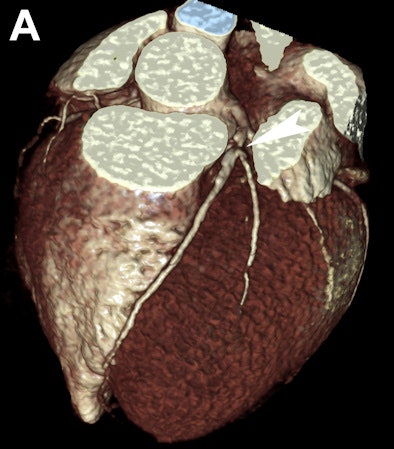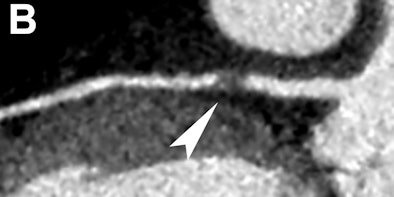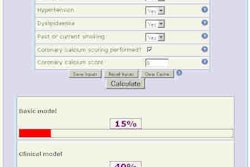
VIENNA - CT angiography (CTA) can act as a gatekeeper in coronary artery disease (CAD), identifying outlier patients and thus enabling dedicated trials to characterize biomarkers and genomics of protective/antiprotective factors, according to a leading Italian cardiac radiologist.
CTA can also help determine the prognostic role of left main artery disease and certain symptoms in these patients, Dr. Filippo Cademartiri, PhD, from Giovanni XXIII Hospital in Monastier di Treviso, Italy, said at last week's European Congress of Radiology (ECR).
Coronary artery disease, which is very prevalent among older populations, affects many patients around the world. In light of this, Cademartiri and colleagues conducted an international, multicenter study to delineate CAD's attributes, such as whether the presence of left main artery disease worsens prognosis and what role symptoms play.
 |
| Images are of a 42-year-old man with atypical chest pain and no significant ECG or troponin alterations. Clinical assessment was in favor of mild pericarditis. CT shows in 3D volume rendering (A) and curved multiplanar reformats (B) the presence of an obstructive atherosclerotic plaque at the proximal left anterior descending coronary artery (arrowhead). Image courtesy of Dr. Filippo Cademartiri, PhD. |
 |
They presented results from the Coronary CT Angiography Evaluation for Clinical Outcomes (CONFIRM) trial in a series of three sessions at ECR. In his explanation of outlier patients, Cademartiri said they are patients for whom there is no apparent relationship between the burden of disease found on CT and what is expected based on conventional risk factors; for instance, absolutely normal coronary arteries in a diabetic patient.
"This is what we call an outlier," he said. "You would expect more -- some degree of coronary artery disease. I don't mean obstructive, I mean coronary artery disease in general."
In a population of 27,125 consecutive patients who underwent CT angiography for suspected CAD, the researchers wheedled them down to 14,966 outliers: 50- to 69-year-old patients with three or more risk factors and absence of CAD, or zero to one risk factor and five or more diseased coronary segments.
The prevalence of significant CAD was found in 19% of this group. Patients with normal coronary arteries accounted for 46% of the total. More than 2,000 (2,189) were in their 50s and more than 1,500 (1,537) were in their 60s. Of the group, 3.7% had three or more risk factors. Patients with five or more diseased coronary segments accounted for 15.4% of the total, and patients with zero to one risk factor accounted for 2.1% of the total.
"This is very exploratory data, and you may ask, why do you want to identify these patients?" Cademartiri said. "CT can identify the patients, and their importance is that they have something different from the others. By identifying these patients and going and studying, for example, their DNA and blood, you could find a way to collect some information which explains the protective or antiprotective role, or some features of the patients that we can use for developing genomics and strategies."
 CT angiography can reveal a host of valuable findings in suspected cases of coronary artery disease, according to Dr. Filippo Cademartiri, PhD, from Treviso, Italy.
CT angiography can reveal a host of valuable findings in suspected cases of coronary artery disease, according to Dr. Filippo Cademartiri, PhD, from Treviso, Italy.
In one of his other two presentations, Cademartiri offered that left main coronary disease presence and severity as detected by CTA seems to be poorly associated with worse prognosis. A total of 7,700 patients without a known history of CAD were included in the study, and 12 coronary artery segments were analyzed.
The researchers determined the following:
- The prevalence of obstructive (> 50%) CAD was 14.7%, whereas 33% of patients had nonobstructive CAD and 52.3% had normal coronary arteries.
- The presence of obstructive and nonobstructive CAD in left main coronary disease was 0.9% and 11%, respectively.
- A total of 95 deaths (1.2%) occurred after a mean follow-up of 29 ± 14 months.
In their multivariate analysis, the researchers found that CAD severity and the number of diseased segments were predictors of all-cause mortality with incremental prognostic value over Framingham risk and calcium score. Risk-adjusted survival showed that the presence of either nonobstructive or obstructive (cutoff > 50%) left main coronary disease was not associated with a significantly worse prognosis. However, after considering a cutoff value of greater than 70% for obstructive CAD, patients with left main coronary disease fared the worst.
Regarding symptoms, the researchers found that CAD severity and typical chest pain appear to be the strongest predictors of mortality within symptom groups.
Out of 7,700 patients, 31.8% were asymptomatic, 48.5% had noncardiac or atypical pain, 11.6% had typical pain, and 8.1% had dyspnea. A significantly higher prevalence of obstructive CAD was observed among patients with typical pain with respect to other symptom categories.
Risk-adjusted survival did not differ significantly between symptom categories; however, the worst prognosis was observed in patients with dyspnea.
The researchers still have another stage of the CONFRIM trial to complete.



















